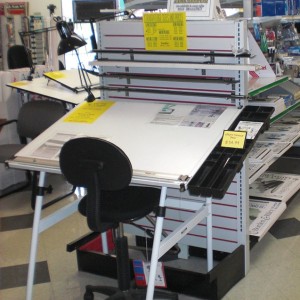Traditional Drafting in the Digital World
 The field of drafting has undergone a number of changes over the last century. When Popular Mechanics Magazine applauded drafting careers in its August, 1958 issue, the magazine’s editors almost certainly could not have imagined the rate at which this profession would evolve over the next 50 years. Admittedly, not a lot of 21st century offices look like this. But do not assume that today’s engineers or fashion designers have never held a straightedge.
The field of drafting has undergone a number of changes over the last century. When Popular Mechanics Magazine applauded drafting careers in its August, 1958 issue, the magazine’s editors almost certainly could not have imagined the rate at which this profession would evolve over the next 50 years. Admittedly, not a lot of 21st century offices look like this. But do not assume that today’s engineers or fashion designers have never held a straightedge.
Technical drawings remain an essential part of the manufacturing process, regardless of product type. The technology may have changed, but the techniques and the principles are essentially the same. Even with the advent of modern CAD and the prevalence of digitalized tools in design and drafting, students and professionals alike see the significance of learning technical drawing skills by hand. Engineering, Architectural and Design majors are taught manual drafting techniques alongside digital software at most colleges. There are also a plethora of small household projects that might call for these types of spatial skills. Plenty of people out there recognize that mapping out a project on paper is the best way to ensure that a household construction or sewing job is done correctly.
Must-have tools of the trade still include a drafting table, a straightedge, a t-square, triangles, French curves and a compass. The brands being bought by today’s technical drawing enthusiasts are yet another aspect that has remained constant over the last half century. Favorites such as Chartpak and Alvin, both of which have been around for well over 50 years, look like babies when compared to traditional drafting companies such as Staedtler and KOH-I-NOOR, both of which began as graphite pencil manufacturers. Staedtler celebrated its 175th anniversary in 2010, and KOH-I-NOOR can be traced back over two centuries to 1790.
To all those who are studying a technical subject, designing their own spring jacket or just love the feel of 0.5 mm lead running across an aluminum straightedge, the art of drafting by hand is alive and well.
By A. Koerber for Du-All Drafting and Art Supply